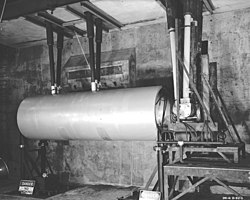Castle Bravo
| Castle Bravo | |
|---|---|

Castle Bravo mushroom cloud
|
|
| Information | |
| Country | United States |
| Test series | Operation Castle |
| Test site | Bikini Atoll |
| Date | March 1, 1954 |
| Test type | Atmospheric |
| Yield | 15 Mt (approx. 63 PJ) |
| SHRIMP | |
|---|---|

The SHRIMP device in its shot cab
|
|
| Type | Teller-Ulam design thermonuclear weapon |
| Production history | |
| Designer | Ben Diven-project engineer |
| Designed | 24 February 1953 (GMT) |
| Manufacturer | Los Alamos National Laboratory |
| Unit cost | About $2,666,000 (1954 USD) |
| Produced | October 1953 (GMT) |
| Number built | 1 |
| Variants | TX-21C, TX-26 |
| Specifications | |
| Weight | 10,659 kilograms (23,499 lb) |
| Length | 455.93 centimeters (179.50 in) |
| Diameter | 136.90 centimeters (53.90 in) |
|
|
|
| Filling | Lithium-6 deuteride |
| Filling weight | 400 kilograms (880 lb) |
| Blast yield | 15 megatons of TNT (63 PJ) |
Castle Bravo was the code name given to the first United States test of a dry fuel hydrogen bomb, detonated on March 1, 1954, at Bikini Atoll, Marshall Islands, as the first test of Operation Castle. Castle Bravo was the most powerful nuclear device ever detonated by the United States, with a yield of 15 megatons of TNT (30% of the energy produced by the most powerful device ever detonated, the Tsar Bomba). That yield, far exceeding the expected yield of 4 to 8 megatons, combined with shifting winds, led to the most significant accidental radioactive contamination ever caused by the United States.
Fallout from the detonation—intended to be a secret test—fell on residents of Rongelap and Utirik atolls and spread around the world. The islanders were not evacuated until three days later and suffered radiation sickness. They were returned to the islands three years later but were removed again when their island was found to be unsafe. The 23 crewmembers of the Japanese fishing vessel Daigo Fukuryū Maru ("Lucky Dragon No. 5") were also contaminated by fallout, experiencing acute radiation syndrome. The blast created an international reaction about atmospheric thermonuclear testing.
The device was a very large cylinder weighing 23,500 pounds (10.7 t) and measuring 179.5 inches (4.56 m) in length and 53.9 inches (1.37 m) in diameter. It was mounted in a "shot cab" on an artificial island built on a reef off Namu Island, in the Bikini Atoll. A sizable array of diagnostic instruments was trained on it, including high-speed cameras trained through an arc of mirror towers around the shot cab.
...
Wikipedia
